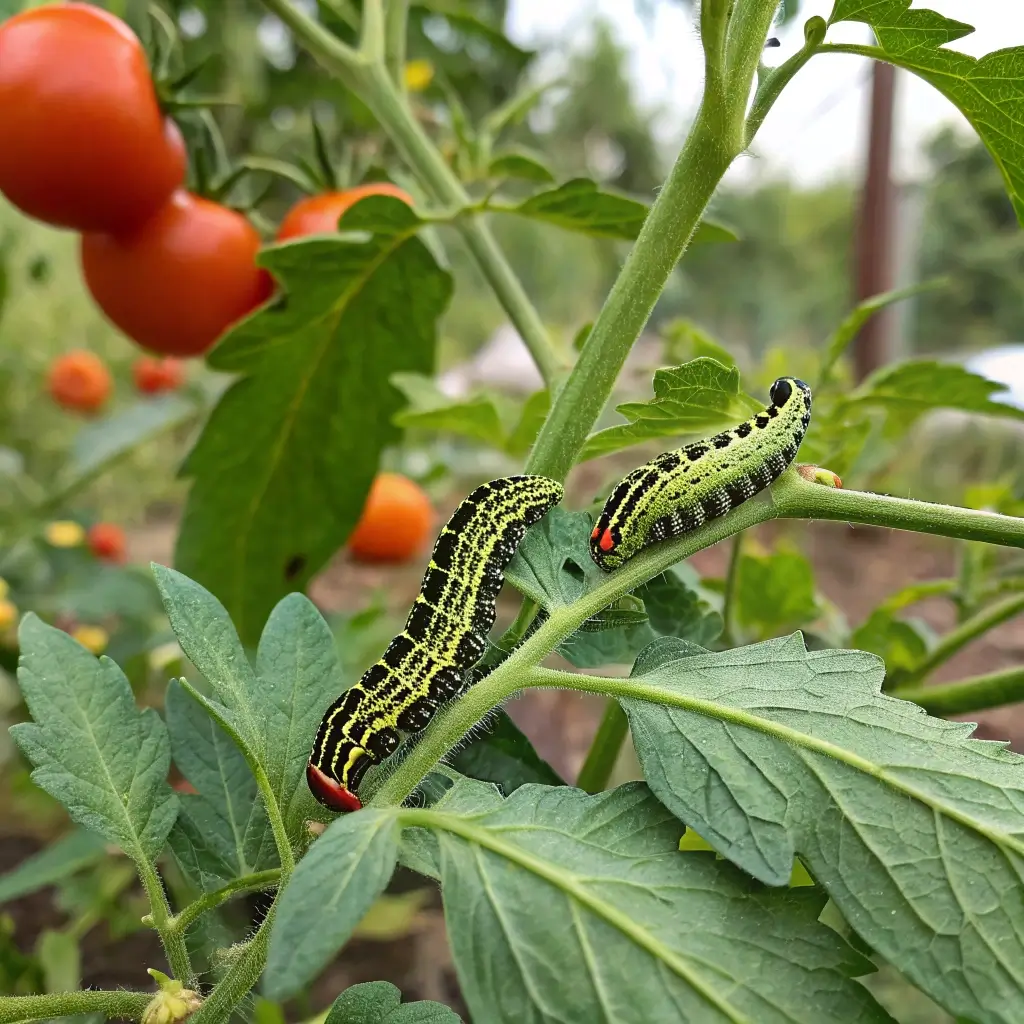7 Common Tomato Caterpillars (+ How to Deal with Them)
Table of Contents
Introduction
Did you know that home gardeners lose an estimated 30% of their tomato crops to caterpillar damage each year? Despite this alarming statistic, most gardeners can’t identify more than two types of the common tomato caterpillars that feast on their prized plants. Understanding these 7 common tomato caterpillars (+ how to deal with them) can be the difference between a bountiful harvest and disappointment. Whether you’re a seasoned gardener or just starting your first vegetable patch, this comprehensive guide will help you identify these pests and implement effective, environmentally friendly solutions to protect your tomatoes.
The 7 Most Common Tomato Caterpillars
1. Tomato Hornworm (Manduca quinquemaculata)
These large, green caterpillars with distinctive white V-shaped markings and a horn-like projection are perhaps the most notorious tomato pests. Growing up to 4 inches long, they can devour entire tomato leaves overnight and even attack the fruit. Their large size makes them relatively easy to spot, though their green coloration provides excellent camouflage among tomato foliage.
2. Tobacco Hornworm (Manduca sexta)
Often confused with tomato hornworms, tobacco hornworms have diagonal white stripes rather than V-shaped markings and a curved red horn. They cause similar damage and are equally voracious, capable of consuming three times their body weight in vegetation daily.
3. Tomato Fruitworm (Helicoverpa zea)
Also known as corn earworms or cotton bollworms, these pests are particularly destructive because they tunnel directly into tomato fruits. Their coloration varies from green to brown with light stripes running lengthwise, making them harder to spot than hornworms.
4. Cutworms (Various Noctuidae species)
These C-shaped caterpillars hide in soil during the day and emerge at night to chew through young plant stems at soil level, literally “cutting down” plants. Colors range from gray to brown with various markings, and they target seedlings and young transplants particularly.
5. Cabbage Loopers (Trichoplusia ni)
Named for their looping movement, these pale green caterpillars have thin white stripes running down their sides. While they prefer cabbage family plants, they readily attack tomatoes when available, creating irregular holes in leaves.
6. Armyworms (Spodoptera species)
These caterpillars “march” across gardens in large numbers, hence their military name. They typically have dark stripes running lengthwise on their bodies against a lighter background color. Beet armyworms and fall armyworms are common tomato attackers.
7. Tomato Pinworms (Keiferia lycopersicella)
These small (¼ inch) caterpillars begin their attack by mining between leaf surfaces before eventually moving to fruits. Their damage appears as small, winding trails in leaves and tiny holes in fruits that can lead to rot.
Effective Management Strategies
Physical Removal
Hand-picking caterpillars remains surprisingly effective, especially for larger species like hornworms. Research shows that regular inspection (3-4 times weekly) and manual removal can reduce caterpillar damage by up to 70% in small garden plots. Wear gloves and drop caterpillars into soapy water to dispose of them humanely.
Biological Controls
Beneficial insects are your allies in caterpillar management:
- Parasitic wasps (particularly Braconid wasps) lay eggs on hornworms, with their white cocoons visible on the caterpillar’s back
- Lacewings and ladybugs consume caterpillar eggs before they hatch
- Studies show gardens with diverse flowering plants host 60% more beneficial insects than monoculture plots
Bacillus thuringiensis (Bt)
This naturally occurring soil bacterium produces proteins toxic to caterpillars but harmless to humans, pets, and beneficial insects. Apply Bt as a spray when caterpillars are young and actively feeding. It breaks down in sunlight within 1-3 days, making it an environmentally responsible choice that won’t harm pollinators when used properly.
Row Covers
Physical barriers like floating row covers prevent adult moths and butterflies from laying eggs on tomato plants. Install them early in the season, ensuring they’re secured at ground level while allowing enough slack for plant growth. Remove temporarily during flowering to allow pollination unless you’re willing to hand-pollinate.
Companion Planting
Strategic plant pairings can reduce caterpillar pressure:
- Marigolds repel various pests and attract beneficial insects
- Basil planted with tomatoes has been shown to reduce hornworm populations by up to 25%
- Dill attracts parasitic wasps that target caterpillars
Neem Oil Applications
This plant-derived oil disrupts feeding and growth in caterpillars while being relatively gentle on beneficial insects when used correctly. Apply in the evening to avoid harming pollinators, focusing on leaf undersides where eggs are often deposited.
Maintaining Plant Health
Robust, healthy plants can better withstand minor caterpillar damage. Proper spacing improves air circulation and visibility for spotting pests, while appropriate watering and feeding practices reduce plant stress. Research indicates well-maintained tomato plants can tolerate up to 15% leaf damage without significant yield reduction.
Prevention Techniques
Garden Cleanup
Remove plant debris after harvest since many caterpillar species overwinter in garden litter. Studies show fall cleanup can reduce spring pest populations by up to 50%. Till soil in early spring to expose overwintering pupae to predators and harsh conditions.
Crop Rotation
Avoid planting tomatoes or related plants (peppers, eggplants, potatoes) in the same location year after year. A 3-year rotation plan can disrupt pest life cycles and reduce caterpillar pressure by approximately 30%.
Monitoring and Early Detection
Install black light traps to detect adult moths before egg-laying begins. Check tomato plants bi-weekly for eggs and small caterpillars, paying special attention to leaf undersides. Early detection allows for intervention before populations explode.
Conclusion
Armed with knowledge about these 7 common tomato caterpillars (+ how to deal with them), you’re now equipped to protect your tomato harvest using integrated pest management techniques. By combining physical, biological, and selective chemical controls as needed, you can minimize damage while maintaining environmental balance in your garden. Remember that complete elimination is rarely necessary or desirable—the goal is to keep pest populations below harmful thresholds while preserving beneficial insects and garden ecology.
FAQs
Are hornworms poisonous to humans or pets?
Despite their intimidating appearance, hornworms are not poisonous or dangerous to handle. Their horn-like projection cannot sting, though some people may experience mild skin irritation from contact.
Can I use diatomaceous earth for caterpillar control?
Diatomaceous earth has limited effectiveness against caterpillars as their soft bodies don’t easily dehydrate from contact. It’s better suited for controlling crawling insects with hard exoskeletons.
Will removing caterpillars harm butterfly populations?
Most caterpillars that damage tomatoes become moths rather than butterflies. You can support butterfly populations by planting dedicated butterfly host plants away from your vegetable garden.
How can I tell if Bt is working?
After Bt application, caterpillars will stop feeding within hours but may remain on plants for 2-3 days before dying. Their lack of movement and feeding is your first indication of success.
Should I use pesticides if I have a severe infestation?
Chemical pesticides should be a last resort for severe infestations. If necessary, choose products specifically labeled for caterpillars on edible plants and follow application instructions precisely to minimize impacts on beneficial insects and harvest safety.







